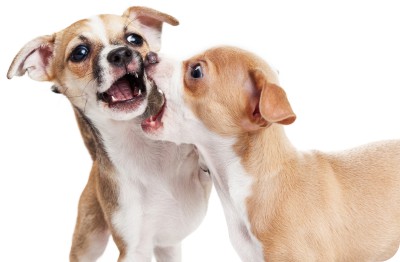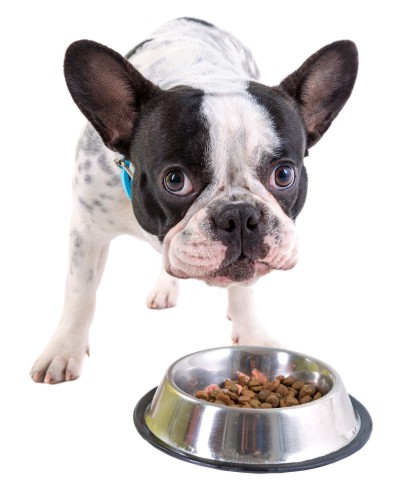 Food aggression is a form of resource guarding in which a dog becomes very defensive when eating and will use threats to force others away. It can be directed towards other animals, humans, or both. The behaviour can also extend to treats and for food that isn’t even intended for the dog.
Food aggression is a form of resource guarding in which a dog becomes very defensive when eating and will use threats to force others away. It can be directed towards other animals, humans, or both. The behaviour can also extend to treats and for food that isn’t even intended for the dog.
Food aggression can become very dangerous for all members of the household. My foster dog Shiloh came with terrible food aggression and used to attack my other dog and my partner if food was being prepared and he thought he would miss out. Below are some suggestions to try to improve the behaviours in your own dog.
Signs of food related aggression
In order to treat this problem, you first need to know what you are looking for. Typically, a dog who is food aggressive will show very obvious body postures and behaviours that will alert you to the problem in or around food. Your dog’s body will stiffen, especially around the head and shoulders. The pupils will dilate and you may be able to see more of the white in the dog’s eyes. Piloerection (or visible heckles) may occur as the threat becomes larger. The ears will tuck back and depending on the breed, the tail will stiffen and fall to a down or tucked position.
You may also get verbal cues from your dog. These include snaring, growling, snapping or biting. It is important to understand your dog’s cues and learn to stay away when unsafe. Having said that, there are things you can do to lower the risk for you and your dog.
Suggested Treatment Ideas
 Avoidance By avoiding situations where your dog gets so stressed it feels it needs to react in an aggressive manor, you avoid all of the unwanted behaviour coming to the surface. This is by far the best thing you can do for your food aggressive dog. This may be something that you will have to do for several weeks in a dog showing mild behaviours, or for a lifetime for a dog that has severe food aggression, like Shiloh. But remember whatever you decide to implement, you must remain fair and consistent.
Avoidance By avoiding situations where your dog gets so stressed it feels it needs to react in an aggressive manor, you avoid all of the unwanted behaviour coming to the surface. This is by far the best thing you can do for your food aggressive dog. This may be something that you will have to do for several weeks in a dog showing mild behaviours, or for a lifetime for a dog that has severe food aggression, like Shiloh. But remember whatever you decide to implement, you must remain fair and consistent.
You can achieve this by:
1. Keep things tidy – by this I mean reduce the amount of opportunity your dog has to react. Pick bowls, kongs etc. Immediately after your dog has finished eating. This removes their chance of coming back and becoming possessive over the object.
2. Feed your dog in a low traffic area. By choosing an area in the house or yard that is quiet and protected from other dogs and people, it will allow your dog to become calm and feel unthreatened at dinner time. This is particularly useful for those households that have young children or are multiple dog households. This way everyone who is venerable is kept a safe distance away from the reactive dog.
3. Do not allow free-feeding options to your dog. By this I mean do not leave food (kibble) out all of the time for them. Also long lasting treats such a rawhide should not be given. If your dog needs long stimulation, offer things other than food such as plastic chew toys specifically designed for chewing. Also providing other stimulation through “play” will keep your dog entertained, without including food.
4. Teach your dog the “Say Please” approach. By getting your dog to sit or drop for their food you are teaching the dog that you are the pack leader and provider, and should therefore be respected. If there is guarding against a particular member of the family this is a good way to teach the dog all people should be respected. It may not help directly with food aggression but it is a good start!
5. Teach your dog “Drop it” or “Leave it” commands. Always teach your dog new commands in a safe and fun manner. First try this command with one of their toys, or an object they see less valuable than food. Once they have mastered this, progress to trying it with treats and then eventually their meal. Remember consistency and positive rewards are the key here!
6. The very last thing you can try, although not recommended as an ongoing solution is the “Trade” cue. Ultimately you bribe your dog with something more valuable than its food to move the dog away from this present situation. This is only a temporary measure that is useful so the human can pick up the food without escalating the situation.
Desensitisation and Counter-conditioning
For many dogs, desensitisation and counter-conditioning is not necessary; avoidance is a superior long-term treatment option. Some risk is involved with desensitisation and counterconditioning. A slip-up could result in aggression and injury to the owners. It is best not to attempt this treatment until avoidance strategies have been implemented successfully and at least a month has passed without confrontations over food items.
I hope you have found this helpful. I would love to hear peoples’ experiences with their own dogs and the techniques that worked for you! Please comment below.